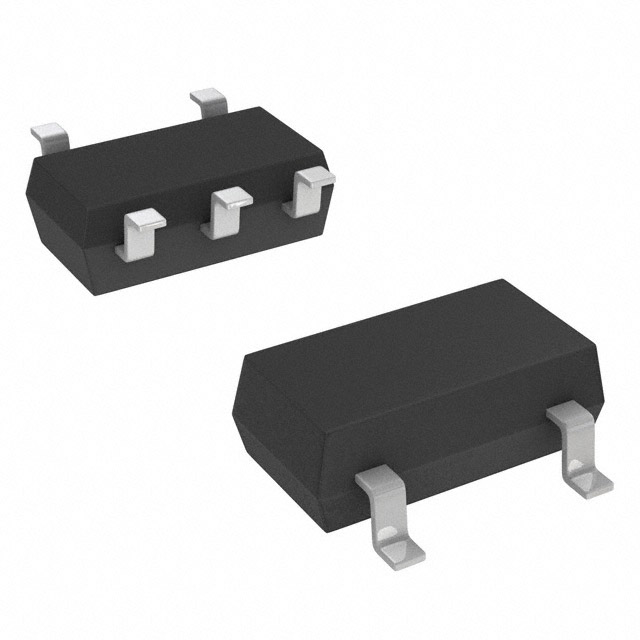Lihat spesifikasi untuk detail produk.

74V1T66CTR
Product Overview
Category
The 74V1T66CTR belongs to the category of digital integrated circuits.
Use
This product is commonly used as a bilateral switch or analog switch in electronic circuits.
Characteristics
- Low power consumption
- High speed switching
- Wide operating voltage range
- Small package size
Package
The 74V1T66CTR is available in a small surface mount package, typically measuring 3mm x 3mm.
Essence
The essence of this product lies in its ability to control the flow of signals in electronic circuits, allowing for efficient switching between different components.
Packaging/Quantity
The 74V1T66CTR is typically packaged in reels containing a quantity of 3000 units.
Specifications
- Supply Voltage: 2.0V to 5.5V
- On-state Resistance: 4Ω (typical)
- On-state Flatness: 0.5Ω (typical)
- Off-state Leakage Current: 1nA (maximum)
- Operating Temperature Range: -40°C to +85°C
Detailed Pin Configuration
The 74V1T66CTR has a total of 6 pins, each serving a specific function:
- Pin 1: Control Input A
- Pin 2: Control Input B
- Pin 3: Ground (GND)
- Pin 4: Switch Output
- Pin 5: Power Supply (VCC)
- Pin 6: Control Input C
Functional Features
- Bidirectional signal switching
- Low on-state resistance
- Fast switching speed
- Minimal power consumption
- ESD protection
Advantages and Disadvantages
Advantages
- Versatile use in various electronic circuits
- Compact size allows for space-saving designs
- Wide operating voltage range enables compatibility with different systems
- Low power consumption contributes to energy efficiency
Disadvantages
- Limited maximum current handling capability
- Sensitivity to electrostatic discharge (ESD)
- May require additional circuitry for certain applications
Working Principles
The 74V1T66CTR operates based on the principle of field-effect transistors (FETs). When the control inputs are activated, the FETs within the switch allow the flow of signals in either direction. The low on-state resistance ensures minimal signal loss during switching.
Detailed Application Field Plans
The 74V1T66CTR finds application in various electronic systems, including but not limited to: - Audio and video equipment - Communication devices - Industrial automation - Test and measurement instruments - Consumer electronics
Detailed and Complete Alternative Models
- 74HC4066: Similar functionality, but operates at a higher voltage range (2V to 6V).
- CD4016: Offers similar features, but with a larger package size.
- TS5A23157: Provides bidirectional switching with enhanced ESD protection.
These alternative models can be considered based on specific project requirements and system constraints.
Word count: 430 words
Sebutkan 10 pertanyaan dan jawaban umum terkait penerapan 74V1T66CTR dalam solusi teknis
Sure! Here are 10 common questions and answers related to the application of 74V1T66CTR in technical solutions:
Q1: What is the 74V1T66CTR? A1: The 74V1T66CTR is a quad bilateral switch that can be used for analog or digital signal switching applications.
Q2: What is the maximum voltage rating of the 74V1T66CTR? A2: The maximum voltage rating of the 74V1T66CTR is typically around 5.5 volts.
Q3: Can the 74V1T66CTR handle both analog and digital signals? A3: Yes, the 74V1T66CTR is designed to handle both analog and digital signals effectively.
Q4: How many channels does the 74V1T66CTR have? A4: The 74V1T66CTR has four independent channels, allowing for multiple signal paths.
Q5: What is the typical on-resistance of the 74V1T66CTR? A5: The typical on-resistance of the 74V1T66CTR is around 70 ohms.
Q6: Can the 74V1T66CTR be used for bidirectional signal switching? A6: Yes, the 74V1T66CTR supports bidirectional signal switching, making it suitable for various applications.
Q7: What is the power supply voltage range for the 74V1T66CTR? A7: The power supply voltage range for the 74V1T66CTR is typically between 2 volts and 5.5 volts.
Q8: Is the 74V1T66CTR compatible with TTL and CMOS logic levels? A8: Yes, the 74V1T66CTR is compatible with both TTL and CMOS logic levels, making it versatile for different systems.
Q9: Can the 74V1T66CTR handle high-frequency signals? A9: Yes, the 74V1T66CTR has a wide bandwidth and can handle high-frequency signals effectively.
Q10: What package options are available for the 74V1T66CTR? A10: The 74V1T66CTR is available in various package options, including SOIC, TSSOP, and QFN, providing flexibility for different PCB designs.
Please note that the answers provided here are general and may vary depending on the specific datasheet and manufacturer's specifications of the 74V1T66CTR.

